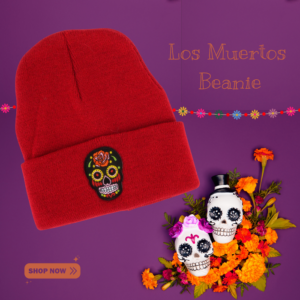Amidst the swirl of autumn leaves and the crisp whisper of fall, a vibrant tapestry of color and memory adorns the landscape. This is no ordinary season. It heralds the time of Los Muertos, a festival rooted deeply in the heart of tradition, bursting with life in the very celebration of the departed.
When Is Día de los Muertos?
Los Muertos is traditionally celebrated on November 1st and 2nd. These dates coincide with the Catholic holidays of All Saints’ Day and All Souls’ Day. The multi-day holiday focuses on gatherings of family and friends to pray for and remember friends and family members who have died, and help support their spiritual journey.
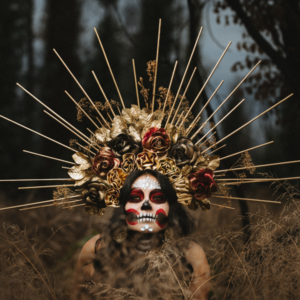
The Story of Los Muertos
The origins of Los Muertos trace back to the indigenous cultures of Mexico. Their belief in the cyclical nature of life fashioned a festival unlike any other. It is intertwining respect, love, and celebration. The dia de muertos origins are a testament to this enduring legacy. Its bridges the gap between the Aztec rituals and the Catholic influences brought by Spanish conquistadores. This cultural alchemy gave birth to the Day of the Dead, a festival that honors those who have crossed into the afterlife with a jubilant affirmation of their memories.
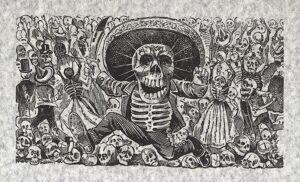
Ancients marked this time with bonfires and offerings to guide the spirits on their journey. Today, the essence of the festival still dances in the streets. Altars rise, bedecked with marigolds, symbolizing the fragility of life. The Dia de los Muertos altar meaning goes beyond mere decoration. It serves as a beacon for the spirits, with each offering steeped in heartfelt significance.
Celebration Through the Ages
Centuries have transformed the Los Muertos festival but the soul remains unchanged. Where ancients once whispered into the night, modern festivities bellow with music and laughter. The Dia de los Muertos candles meaning has kept their flame alight through the ages; each light is a sentinel against the darkness, a guide for the wandering souls to find their way back home.
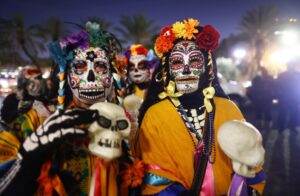
Families create altars, not as somber tombs, but as vivid celebrations of life. They adorn them with photographs, dia de los muertos stories, favorite foods, and bread of the dead. These offerings, or ‘ofrendas,’ speak the language of love and remembrance, echoing the ethos of memento mori—a reminder that life, though fleeting, is to be cherished.
Dia de Muertos Costume Tradition
Adorning oneself in the spirit of Dia de Muertos transcends mere festivity; it is a profound homage to the souls that dance invisibly among us. The tradition of dressing up—a kaleidoscope of skeletons and Catrinas—embodies the festival’s heart, painting the line between life and death with a stroke of whimsy.
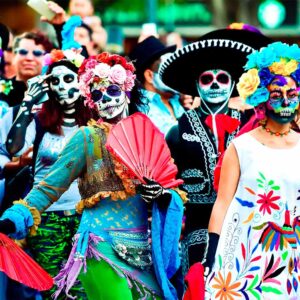
These costumes carry symbolic weight; they are not just garments but stories woven in fabric, celebrating the cycle of life. The skeletal visages, grinning broadly, are not tokens of fear but emblems of unity with the departed. They remind us that beneath it all, we share the same bones, the same humanity. This powerful sartorial expression allows the living to walk alongside the spirits, if only for a night, in a vivid tapestry that honors those who have traversed beyond the veil.
Crafting Your Own Los Muertos Altar
In the heart of the home, a Los Muertos altar becomes a focal point of the festival—a sacred space where the veil between worlds thins. Crafting such an altar embodies both artistry and intent. Begin by choosing a space imbued with tranquility and respect. Cover this with a cloth of rich, earthy tones or vibrant hues, setting the stage for the items to come. Traditional altars span three levels, representing the ascent to the afterlife, but even a single tier can capture the essence.

Place photographs of the departed at the center, surrounded by dia de los muertos candles meaning illumination and passage. Add elements of earth, wind, water, and fire to represent the essential forces of life: food to nourish the spirits, papel picado fluttering in the air, a bowl of water to quench their thirst, and the candles’ flames to light their way. Include the fragrant marigold, known as cempasúchil; its petals form a path for the souls to follow. Don’t forget to sprinkle the area with salt—its purity sanctifies the ground.
Personalize this sacred space with the favorite items of the remembered. A hat, a musical instrument. Also a book—each object telling a silent tale of love, a life, a moment. Finish by placing a piece of pan de muerto on the altari. It will symbolize the bounty of the earth and the sweetness of life.
The Heart of Los Muertos Tradition
Beyond the revelry and bright hues lies the core of dia de los muertos meaning. It is a poignant reflection on the impermanence of life, a lesson to hold dear to those who walk the journey with us, and to honor the footsteps of those who have gone ahead. Los Muertos teaches the living to embrace the beauty of existence, to remember without sorrow, and to live with a spirit as vibrant as the festival itself.
Connection Between Samhain and Halloween
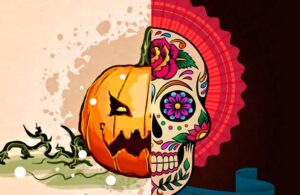
As autumn’s chill deepens, Los Muertos shares the season with Samhain and Halloween, each a different cultural mirror reflecting on death and the afterlife. While Samhain, with its Celtic roots, speaks of the end of the harvest and the beginning of winter, Halloween revels in the playful acknowledgment of ghosts and ghouls. Day of Dead, however, offers a unique perspective—a celebration not of death itself, but of the dead and their lasting impact on the world of the living.
A Legacy of Life in the Dance of Death
Los Muertos stands out as a luminescent thread in the cultural tapestry of humanity. A great symbol for Memento Mori. Its message resonates universally: love transcends the physical realm, and honoring those who have departed reaffirms the value of the life that pulses within us. As the festival candles flicker in the twilight, one is reminded that each light is a story, a memory, a life celebrated not for how it ended, but for how it was lived.

